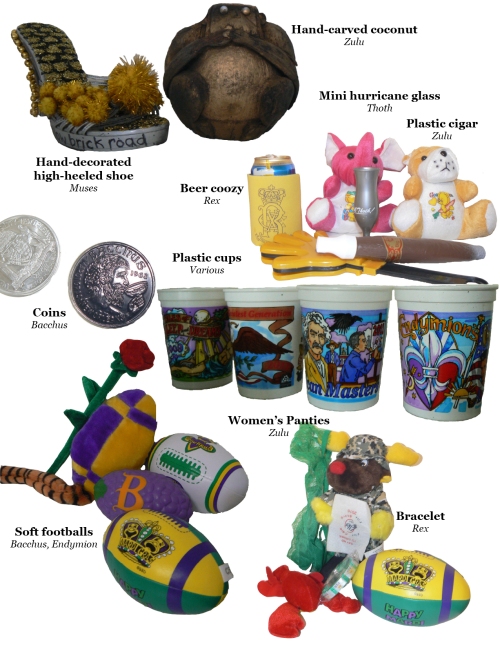Beads thrown from the floats get caught in trees off the parade routes. You can still find them dangling there all year long.
Thanks for reading all our Mardi Gras 2011 coverage this week! Let us know if you’re going next year…
–Tara for TKGO
Beads thrown from the floats get caught in trees off the parade routes. You can still find them dangling there all year long.
Thanks for reading all our Mardi Gras 2011 coverage this week! Let us know if you’re going next year…
–Tara for TKGO
Posted in Shot of the Week
Tagged 2011, Louisiana, Mardi Gras, New Orleans, parade, Shot of the Week, Tara
Mardi Gras is all about sharing. When you want something your neighbor caught four of, you’ll believe me.
But there are some items you won’t give away, no matter how much little kids stare and adults drool. Ladies and gentlemen, TKGO picks the top throws from Mardi Gras 2011:
 So how do you catch these awesome things? A few tips:
So how do you catch these awesome things? A few tips:
Beggars can’t be choosers. A sign that reads “Mini Hurricane Glasses, Please!” will only get you angry glares. But at the Muses parade, an all-women krewe where the coveted throw is a hand-decorated high heeled shoe, the more playful, less demanding signs (“Mama needs a new pair of shoes!”) got plenty of laughs from krewe members and a shoe for the spectator.
Make eye contact with one krewe member on the float. It doesn’t necessarily take words to form a friendship. Don’t forget your manners! Thank them afterward for what they throw you—they may toss something else your way!
Befriend spectators standing next to you. If they know you want something they already have, trade! (They also may know someone in the parade, which can’t hurt.)
Sing the Saints song or show some general spirit. Who from New Orleans doesn’t cheer for their teams? Krewe members do…
And if you’re really desperate, hang out at the parade origin to hear the announcements of which float each krewe member is assigned. Call their names as the float passes by and hope you look like someone they actually know.
Any helpful tips or favorite throws? Share them in the comments!
–Tara for TKGO
Zulu feels different from many of the other parades. They borrow a few floats from other krewes and throw beads made for parades as far back as 2009, but the sentiment here is unrivaled.
The Zulu Social Aid and Pleasure Club isn’t called a krewe—it was founded in 1916 before the term was popular—but it is one. Zulu is one of the oldest organizations to march. Their parade takes place at 8 a.m. on Fat Tuesday, so the highly motivated will stay up all night on Monday and go to bed after the parade ends Tuesday morning. (If you plan to do this, you should know Zulu’s notorious reputation for running late.)
The Zulus offer arguably the most sought-after throw of Mardi Gras—the coconut. A throw is anything given away by krewe members on the floats or walking through the streets during the parade, and can range from plain sets of beads to pendants to an item exclusive to that krewe. Zulu’s coconuts are hand-painted and/or carved by individual members of the krewe, so they don’t throw them to just anyone.
In the Civil Rights Movement in the 1960’s, Zulu ran into controversy with its costumes—grass skirts and blackface don’t exactly promote racial equality. You’ll still see the marching Zulus wearing this in recent parades, and in fact they are known for the intricacy and detail used to construct their outfits.
–Tara for TKGO
Posted in Events
Tagged 2011, Fat Tuesday, Louisiana, Mardi Gras, New Orleans, parades, Tara, Zulu
The parades are central to Mardi Gras. It’s where you get the beads, hang out with your friends and, for some (most), carry your booze around with you in the street.
Each parade is organized by a krewe (pronounced “crew”), whose members pay for everything they throw to crowds from the floats, from beads to high heeled shoes. Member dues, which can be thousands of dollars a year, pay for float construction and costs associated with the ball typically held the night of the krewe’s parade.
Though the number of floats and length can vary, many feature roughly 30 floats and last for about two hours assuming there are no delays (which there inevitably will be). The bands, cheerleaders and step teams from local schools aren’t restricted to marching in just one parade, so you’ll see them in many as krewes typically give the schools funding in exchange.
Check out some highlights of the Krewe of Thoth (pronounced “toth”) parade through Uptown this year. Thoth was founded in 1947 and its parade is sometimes known as the “Parade of the Shut-Ins”—its route passes 14 institutions for persons with disabilities and illnesses.
Parades run through Fat Tuesday, when the first two still-active krewes march through the streets. The city goes back to “normal” on Ash Wednesday. (It’s all relative.)
–Tara for TKGO
Posted in Events
Tagged 2011, krewe, Louisiana, Mardi Gras, New Orleans, parade, Tara, Thoth, Zulu